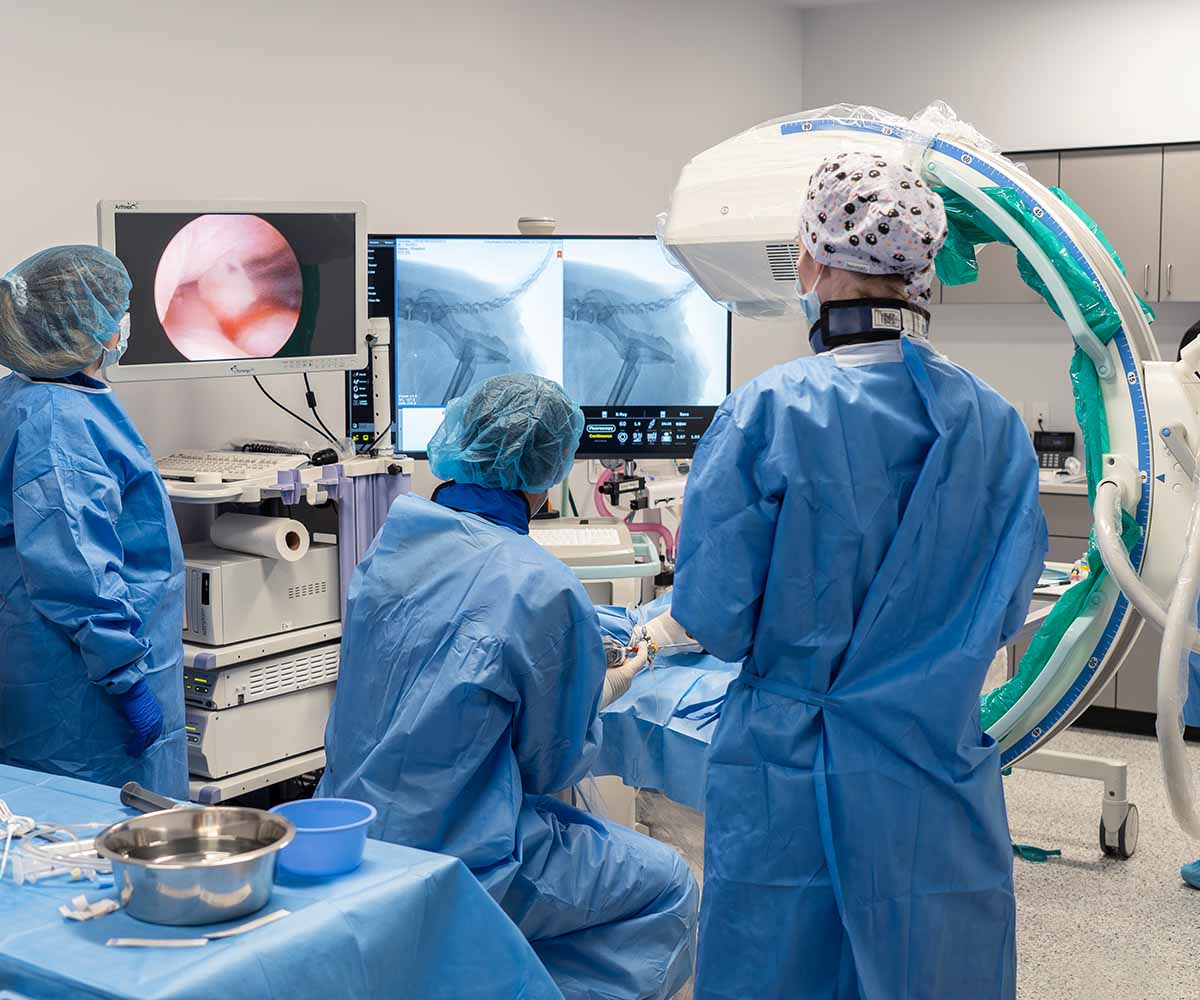Interventional Radiology
Overview | What to Expect | Contact
Interventional Radiology is a medical specialty that leverages advanced imaging technology to diagnose and treat specific conditions in a minimally invasive fashion.
In most cases, interventional radiology allows for better outcomes in conditions that may otherwise not be treatable. This is an area of care that few veterinary facilities in country are able to offer since it requires board certified specialists with advanced training and experience specifically in interventional radiology. VRCCO’s interventional radiology team includes board certified internists and surgeons.
Procedures Available:
Most of these cases can be completely performed without a need for a major open surgical procedure.
- Stents for ureteral obstructions
- Subcutaneous ureteral bypass (SUB)
- Tracheal stenting
- Urethral stenting
- Intrahepatic shunt attenuation
- Tumor embolization
- Ectopic ureter ablation
WHAT TO EXPECT
Interventional Radiology

Each patient will undergo diagnostics specific to the procedure being performed. The most common diagnostics are blood work, x-rays, abdominal ultrasonography or CT scanning. These diagnostics allow the team to make an individualized interventional radiology plan for your pet. Your pet will receive appropriate pain control before, during, and after the procedure.
A question that we are often asked regarding a patient scheduled for a surgical procedure is: “Will my pet be receiving any pain medication?” The short answer is an emphatic, yes!
Fortunately, interventional radiology is performed through very small surgical approaches that limit how much discomfort a patient can experience. That being said, we take pain management very seriously at the Veterinary Referral Center of Central Oregon. Regardless of the reason your pet is with us, such as an emergency visit after a traumatic injury or a planned surgery, appropriate pain management is of paramount importance to us. Any patient that undergoes any type of surgical procedure will receive pain control before, during, and after surgery. We implement a variety of progressive anesthetic and pain management techniques, commonly referred to as a “multimodal anesthetic approach.” This means that we use a combination of pain control techniques, specific to each patient with the goal of providing pain control and minimizing side effects commonly associated with pain medications, such as dysphoria and nausea.
First and foremost, since our pets can’t speak up when they are hurting, veterinary professionals need to be able to read body language and interpret vitals signs for varying species. Even a pet’s personality must be considered when assessing pain. The staff at VRCCO are all thoroughly trained to accurately assess pain on all pets we treat.
Before surgery, each patient receives injectable pain medication. These injections last anywhere from 2-6 hours, depending on which medication is used. Depending on the procedure, patients may also receive an epidural or a local nerve block. These types of pain management provide an additional 4-24 hours of pain control, specific to the region being operated on. We have integrated a long-acting local anesthetic that provides up to 72 hours of postoperative pain management for many of our surgery cases.
Our standard is for any patient that has undergone a major surgical procedure to stay at least one night with us. These patients are kept on intravenous fluids and benefit from intravenous pain management. Most commonly, we control pain through CRI’s – constant rate of infusions. This means that patients are continuously receiving pain medication that is dosed specific to their weight and their individual response to the pain mediation. Dosages for constant rate of infusions are easily adjusted, depending on the patient’s pain levels. CRI’s may be started before, during, or immediately after surgery.
Typically once a patient is eating, we will begin to transition them from intravenous medications to oral medications. Oral medications may include opioids, NSAIDS (non-steroidal anti-inflammatories), or medications for nerve pain. Depending on the procedure, oral pain medication may be prescribed for a few days or a few weeks.
Rest assured that your patient’s comfort is a priority at VRCCO! We will do everything in our power to keep your pet pain free following their procedure.
We use advanced equipment to monitor heart rate, respiratory rate, body temperature, blood pressure, heart rhythm, carbon dioxide levels, and sometimes even blood gasses. Your pet will be closely monitored until they are fully recovered from the anesthetic event. Additional precautions are always taken when performing anesthesia on inherently higher risk patients such as brachycephalic breeds.
Prior to interventional radiology, an IV catheter and endotracheal tube will be placed, IV fluids started, and anesthesia will begin. The surgical area is then clipped and cleaned. While under anesthesia, your pet will be closely monitored by an experienced veterinary nurse anesthetist who will work with the team to ensure a comfortable and uneventful anesthetic event.
All surgical patients will receive overnight, post-operative monitoring by a skilled veterinary staff with doctors in the hospital 24 hours a day. Most patients are ready to go home the next day.
A treatment plan will be provided for any recommended diagnostics and/or treatments. An initial payment will be required for any procedure, surgery, or diagnostic work-up over $600. We gladly partner with CareCredit and Scratchpay to offer financing services to our clients. Please ask our team for more details. We are also happy to assist with submission of pet insurance claims to your pet’s insurance provider. We provide a 10% discount for pet parents in military service.
We accept cash, VISA, Mastercard, Discover, CareCredit and Scratchpay. Personal checks and American Express are not accepted.
EMERGENCY
SPECIALTY CARE
URGENT CARE
FAQ GUIDE
Everything you
need to know.